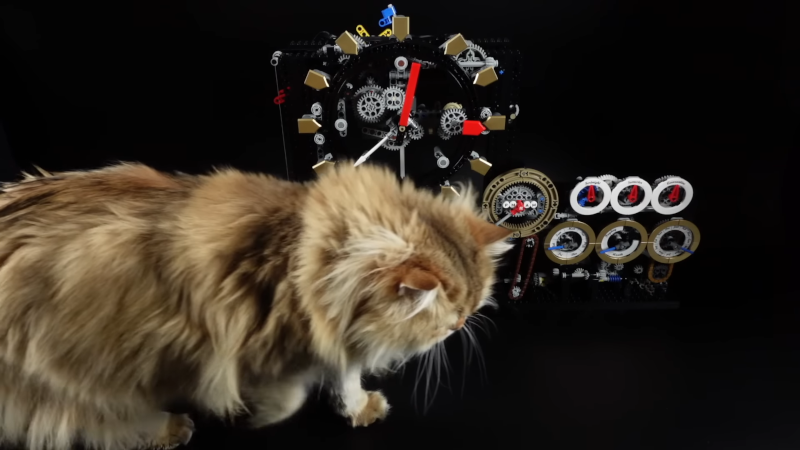If you are a fan of LEGO bricks or Rube Goldberg, you should have a look at [Brick Technology’s] billion-year LEGO clock. Obviously, it hasn’t been tested for a billion years, and we wonder if ABS would last that long, but the video below is still worth watching.
Even if you aren’t a LEGO fan, the demonstration of a pendulum clock and escapement is worth something and really shows the practical side of things. Of course, making a pendulum clock that keeps time isn’t anything magic — people have been doing that for centuries. But then more and more elements join to keep track of more time.
You might wonder how the pendulum keeps going for a billion years. Well, honestly, it can’t. But a solar panel charges a battery that rewinds the clock when the drive weight reaches the bottom. We imagine the solar cell and battery would be maintenance items if you expected the billion-year life cycle.
Some will ask why, but we get it. If you must explain why you build everything you do with LEGO, you are doing it wrong. The clock even keeps track of the galaxy’s rotation which, apparently, completes every 230 million solar years.
We’d be impressed with this clock even if it weren’t made with LEGO. Sure, it isn’t as posh as the fancy clock in Denmark. But it does work longer — at least, in theory — than most other LEGO clocks we’ve seen.
Thanks for the tip [Hari].

















Oops – no leap years
Actually that was taken care of at timeframe 6:43.
Amazing idea and build, too bad it will wear out in just a few years.
The real reason it won’t last a billion years is evident in the Title Photo,
a cat is nearby.
B^)
Constructing any clock intended to last more than 1000 years is pure folly.
Sundial?
Look up the Long Now clock. It is designed to run for 10,000 years and is a majorly thought out design using a mechanical serial but adder. I saw it under construction in SF. It stands a chance assuming geological or vandalism issues don’t ruin it.
Haha autocorrect. Serial BIT adder.
I want to know how many seconds it will drift in 200 million years.
I’ll just leave this here:
https://longnow.org/clock/
>We’d be impressed with this clock even if it weren’t made with LEGO.
Odd statement. Surely it would be more impressive if the person had also designed and manufactured all parts?
There’s a series on YT about recreating the Antikythera mechanism by hand. It is very impressive.
I must be missing something, but I don’t see how that tiny weight can drive the entire gear chain through a zillion-to-one reduction. I wonder how long it actually runs before it binds up. Beautiful video though.
For what it is worth, analog automotive clocks ran by a conceptually similar mechanism. A small coil spring, wrapped partially around a drum, provided motive force for the escapement. This represented sufficient stored energy to run the clock for several minutes. As the clock clock ran down, rotation of the drum brought a pair of contacts together that momentarily energized a solenoid. The solenoid literally slapped a tab on the drum, rewinding it for another n-minute run. In operation, the clock would emit the expected ticking sound, along with a pronounced pop every few minutes.
I enjoyed this project and the video very much. The value in all this is not the clock, rather, it’s the physical expression of a brilliant chain of thought. Well done.
IIRC analog automotive clocks were renowned for their inability to keep time.
Were they even on while the car was powered off? The only purpose being to mark time between waypoints.
They were mechanical clocks with an electric winder. I never heard they were bad. I remember the suggestion of using one at home.
Yes, they were. These weren’t rally clocks or timers. They were real time clocks.
Not rally timers, but navigation timers, for figuring out distances and speeds.
Have a working one from an Opel b Kadett, after sitting for 20+ years it started running as soon as i hooked it up to 12V.
Any Neal Stephenson fans here?
Yes, my Fraa.
How to get more youtube clicks with your extremely low ratio lego gearbox.
It’s a Lego project!!! Lord; quit analyzing it like the guy is trying to win the Nobel Science Prize